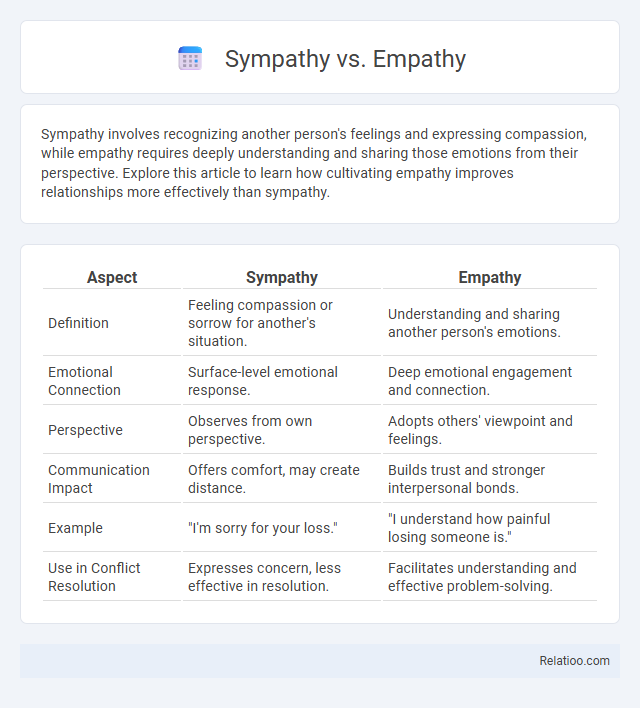Sympathy involves recognizing another person's feelings and expressing compassion, while empathy requires deeply understanding and sharing those emotions from their perspective. Explore this article to learn how cultivating empathy improves relationships more effectively than sympathy.
Table of Comparison
| Aspect | Sympathy | Empathy |
|---|---|---|
| Definition | Feeling compassion or sorrow for another's situation. | Understanding and sharing another person's emotions. |
| Emotional Connection | Surface-level emotional response. | Deep emotional engagement and connection. |
| Perspective | Observes from own perspective. | Adopts others' viewpoint and feelings. |
| Communication Impact | Offers comfort, may create distance. | Builds trust and stronger interpersonal bonds. |
| Example | "I'm sorry for your loss." | "I understand how painful losing someone is." |
| Use in Conflict Resolution | Expresses concern, less effective in resolution. | Facilitates understanding and effective problem-solving. |
Understanding Sympathy: Definition and Origins
Sympathy involves recognizing another person's emotional state and expressing concern or sorrow for their situation, often rooted in shared cultural and social contexts. Its origins trace back to the Greek word "sympatheia," meaning "fellow feeling," emphasizing emotional resonance and compassion without necessarily sharing the other's emotions. Understanding sympathy requires differentiating it from empathy, which entails deeper emotional involvement and perspective-taking beyond mere acknowledgment.
What is Empathy? A Deep Dive
Empathy is the ability to understand and share the feelings of another person by putting oneself in their shoes, enabling deeper emotional connections and effective communication. Unlike sympathy, which involves feeling pity or sorrow for someone's situation, empathy requires immersing oneself in the other's emotional experience to appreciate their perspective authentically. Cognitive empathy involves intellectually understanding another's feelings, while affective empathy entails emotionally resonating with those feelings, both crucial for social bonding and compassion.
Key Differences Between Sympathy and Empathy
Sympathy involves acknowledging another person's hardships and expressing concern, whereas empathy entails deeply understanding and sharing the feelings of others. Empathy can be cognitive, involving perspective-taking, or affective, involving emotional resonance, while sympathy remains at an emotional acknowledgment level without experiencing the other's emotions. Key differences include empathy fostering connection by experiencing emotions firsthand, whereas sympathy maintains emotional distance with compassionate recognition.
The Psychology Behind Sympathy and Empathy
The psychology behind sympathy and empathy reveals distinct emotional processes: sympathy involves feeling concern for another person's suffering while maintaining an emotional distance, whereas empathy requires deeply understanding and sharing their emotional experience. Your ability to engage in empathy activates mirror neurons in the brain, fostering genuine emotional connection and compassion. Research shows that empathy enhances interpersonal relationships and emotional intelligence, making it essential for effective social communication and support.
Why Empathy Matters in Human Connection
Empathy matters in human connection because it enables you to deeply understand and share the emotions of others, fostering trust and meaningful relationships. Unlike sympathy, which involves feeling pity or sorrow for someone, empathy involves experiencing their emotions from their perspective, creating a stronger emotional bond. This genuine connection enhances communication, support, and emotional healing in personal and professional interactions.
How Sympathy Can Impact Relationships
Sympathy involves recognizing another person's hardship and expressing compassion, which can provide comfort but might create emotional distance if overused. Empathy allows you to deeply understand and share someone's feelings, fostering stronger emotional connections and trust in relationships. Your ability to balance sympathy and empathy influences how supported and understood others feel, ultimately shaping the quality of your interpersonal bonds.
Empathy in Everyday Communication
Empathy in everyday communication involves deeply understanding and sharing another person's feelings, which enhances connection and trust more effectively than sympathy's mere acknowledgment of emotions. Unlike sympathy's detached concern, empathy requires active listening and emotional resonance, enabling more meaningful and supportive interactions. Mastering empathy improves interpersonal relationships by fostering genuine care, reducing conflict, and promoting collaboration in both personal and professional contexts.
Building Empathy: Practical Tips and Strategies
Building empathy involves actively listening, observing nonverbal cues, and engaging in perspective-taking to understand others' emotions deeply. Practicing mindfulness and asking open-ended questions enhances emotional connections and fosters genuine compassionate responses. Role-playing and storytelling exercises can also improve empathetic skills by helping individuals experience diverse viewpoints authentically.
Common Misconceptions About Sympathy and Empathy
Sympathy often gets confused with empathy, but while sympathy involves feeling pity or sorrow for someone else's misfortune, empathy requires you to actively understand and share their emotions. A common misconception is that showing sympathy is enough to provide support, but true emotional connection comes from empathy's deeper perspective-taking. Your ability to empathize fosters stronger relationships and more meaningful interactions compared to simply expressing sympathy.
Choosing Empathy Over Sympathy: Real-World Examples
Choosing empathy over sympathy involves understanding and sharing another person's feelings rather than just acknowledging their pain from a distance. For example, healthcare professionals who practice empathy build stronger patient trust by actively listening and validating emotions, leading to better treatment outcomes. In workplace settings, empathetic leaders foster inclusive environments by recognizing employees' challenges and offering tailored support, boosting morale and productivity.

Infographic: Sympathy vs Empathy
 relatioo.com
relatioo.com